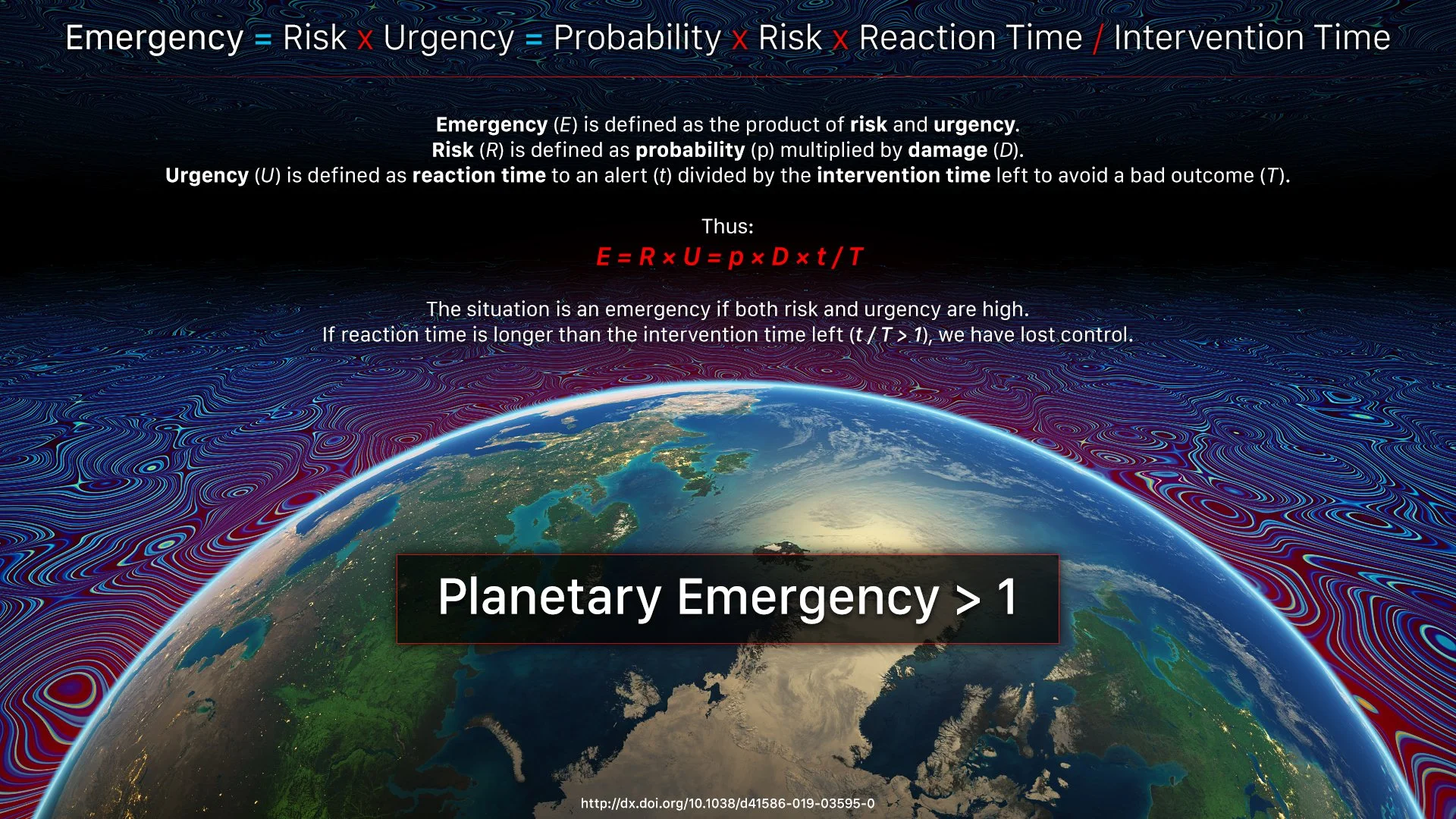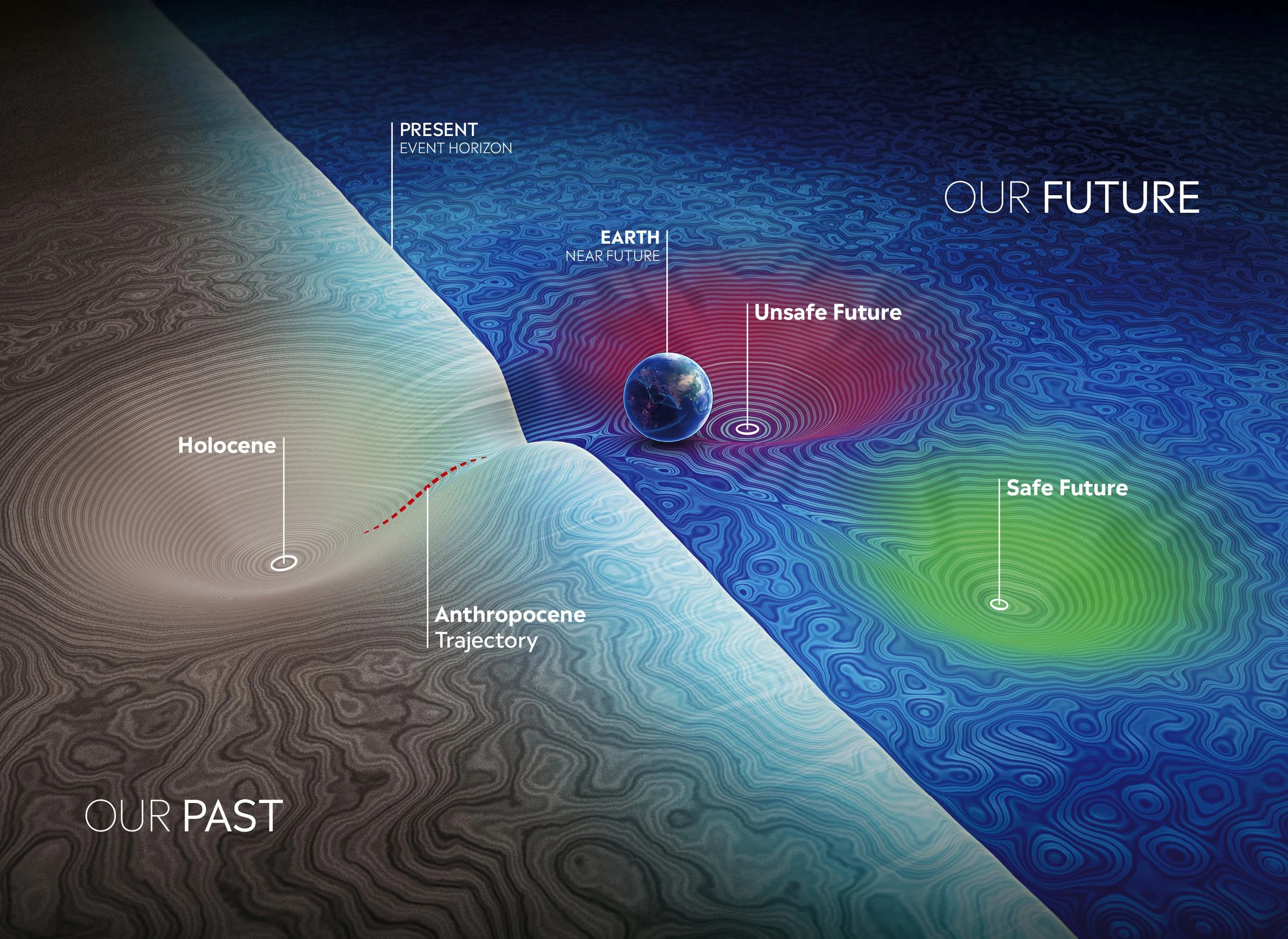
🌍🚨
Planetary Emergency
The Planetary Emergency, mainly defined by the interrelated crises of climate change and biodiversity loss, is an unequivocal, urgent, and pressing issue. This multifaceted crisis (or polycrisis), compounded by the reality of tipping points that could trigger irreversible changes, poses severe threats to the Earth's ecosystems, human societies, and the overall well-being of future generations.
The 2018 IPCC Global Warming of 1.5°C report asserts that to avert disastrous climate disruptions, global CO2 emissions must be halved by 2030 and reach net-zero by 2050. Simultaneously, the 2019 IPBES Global Assessment reveals rapid declines in ecosystems and biodiversity due to human activities.
These stark findings demand immediate attention and should dominate headlines until substantial actions are taken across all levels of society. Achieving sustainability goals for 2030 and beyond requires transformative changes in economic, social, political, and technological factors. We have less than a decade to implement the largest economic transformations ever witnessed, and failure to do so will have dire consequences for our planet and future generations.
See a related project on 🌍⚠️ Existential Risks.
The Planetary Emergency Symbol
Drawing inspiration from brutalism iconography and the Doomsday Clock by the Bulletin of the Atomic Scientists, we offer this symbol as a means to alert people about the planetary emergency. It is a minimalistic and easy-to-reproduce design consisting of a Circle, a Line, and a Point.
The Planetary Emergency Symbol has different levels of reading:
The circle [O] represents our planet and the exclamation mark [!] signifies the concept of an emergency.
The design portrays a clock set at midnight 🕛, representing the polycrisis and existential risks faced by humanity in the Anthropocene.
The connection between the center and the periphery can be interpreted as emphasising the need to address the fundamental issues and root causes of the global crisis, rather than simply addressing the immediate symptoms and proximal factors.
A Planetary State of Emergency?
“It is unequivocal that human influence has warmed the atmosphere, ocean and land. Widespread and rapid changes in the atmosphere, ocean, cryosphere and biosphere have occurred. The scale of recent changes across the climate system as a whole and the present state of many aspects of the climate system are unprecedented over many centuries to many thousands of years. Human-induced climate change is already affecting many weather and climate extremes in every region across the globe.”
“[The] IPCC Working Group 1 report is a code red for humanity. The alarm bells are deafening, and the evidence is irrefutable: greenhouse‑gas emissions from fossil-fuel burning and deforestation are choking our planet and putting billions of people at immediate risk. Global heating is affecting every region on Earth, with many of the changes becoming irreversible.”
The latest and most comprehensive peer-reviewed scientific analyses and syntheses provide an overwhelmingly convincing body of evidence that supports the concepts of the Anthropocene, the Great Acceleration, Planetary Boundaries and Tipping Points. Together, these ideas suggest that the biosphere and human societies are at a critical crossroads, making this decade perhaps the most momentous in history.
By declaring that we are in a state of planetary emergency:
We acknowledge that climatological and ecological tipping points can fundamentally change the conditions for complex life on Earth;
We recognise that human health and planetary health are deeply connected;
We understand that reducing inequality, eradicating poverty and empowering women are the most important solutions for planetary stewardship;
We accept that the time for systemic transformation is now.
Exceeding 1.5°C global warming could trigger multiple climate tipping points
Reference: https://www.science.org/doi/10.1126/science.abn7950
Credit: Globaïa
Earth’s Sleeping Giants Stirring | Nine Tipping Elements Now Active.
Reference: https://www.nature.com/articles/d41586-019-03595-0
Credit: Globaïa
Wait, how can this even be possible?
First, a quick primer on what an emergency actually is.
An emergency (E) is defined as the product of risk and urgency.
Risk (R) is defined as probability (p) multiplied by damage (D).
Urgency (U) is defined as reaction time to an alert (t) divided by the intervention time left to avoid a bad outcome (T). Thus:
E = R × U = p × D × t / T
Emergency = Risk x Urgency
= Probability x Risk x Reaction Time / Intervention Time
The situation is an emergency if both risk and urgency are high.
If reaction time is longer than the intervention time left (t / T > 1), we have lost control.
A recent study (2019) argues “[…] that the intervention time left to prevent tipping could already have shrunk towards zero, whereas the reaction time to achieve net zero emissions is 30 years at best. […] The stability and resilience of our planet is in peril. International action — not just words — must reflect this.”
Timothy M. Lenton, Johan Rockström, Owen Gaffney, Stefan Rahmstorf, Katherine Richardson, Will Steffen & Hans Joachim Schellnhuber. Climate tipping points — too risky to bet against. Nature 575, 592-595 (2019).
In 2018, the Intergovernmental Panel on Climate Change (IPCC) published the authoritative Global Warming of 1.5°C report in response to the Paris Agreement, which assessed the risks associated with an increase in temperatures of 1.5°C above pre-industrial mean surface values. To avoid catastrophic climate disruptions, it concluded, global CO2 emissions must be halved by 2030 until net-zero emissions are reached by 2050. The maths are excruciatingly merciless and unambiguous: we have less than a decade to operate the largest economical transformations the world has ever experienced.
IPCC, 2018: Summary for Policymakers. In: Global Warming of 1.5°C. An IPCC Special Report on the impacts of global warming of 1.5°C above pre-industrial levels and related global greenhouse gas emission pathways, in the context of strengthening the global response to the threat of climate change, sustainable development, and efforts to eradicate poverty [Masson-Delmotte, V., P. Zhai, H.-O. Pörtner, D. Roberts, J. Skea, P.R. Shukla, A. Pirani, W. Moufouma-Okia, C. Péan, R. Pidcock, S. Connors, J.B.R. Matthews, Y. Chen, X. Zhou, M.I. Gomis, E. Lonnoy, T. Maycock, M. Tignor, and T. Waterfield (eds.)]. World Meteorological Organization, Geneva, Switzerland, 32 pp.
In 2019, the Intergovernmental Science-Policy Platform on Biodiversity and Ecosystem Services (IPBES) wrote in its seminal global assessment that "[n]ature across most of the globe has now been significantly altered by multiple human drivers, with the great majority of indicators of ecosystems and biodiversity showing rapid decline."
This alone should raise red flags all across the world and make daily headlines until strong actions are undertaken at all levels of society. The report also made this observation: "Goals for conserving and sustainably using nature and achieving sustainability cannot be met by current trajectories, and goals for 2030 and beyond may only be achieved through transformative changes across economic, social, political and technological factors."
IPBES (2019): Summary for policymakers of the global assessment report on biodiversity and ecosystem services of the Intergovernmental Science-Policy Platform on Biodiversity and Ecosystem Services. S. Díaz, J. Settele, E. S. Brondízio E.S., H. T. Ngo, M. Guèze, J. Agard, A. Arneth, P. Balvanera, K. A. Brauman, S. H. M. Butchart, K. M. A. Chan, L. A. Garibaldi, K. Ichii, J. Liu, S. M. Subramanian, G. F. Midgley, P. Miloslavich, Z. Molnár, D. Obura, A. Pfaff, S. Polasky, A. Purvis, J. Razzaque, B. Reyers, R. Roy Chowdhury, Y. J. Shin, I. J. Visseren-Hamakers, K. J. Willis, and C. N. Zayas (eds.). IPBES secretariat, Bonn, Germany. 56 pages.
We are not doing nearly enough, we must change.
“I am here to sound the alarm: The world must wake up. We are on the edge of an abyss — and moving in the wrong direction.”
The Planetary Emergency.
Our Homeworld · Going through gradual or abrupt changes.
Credit: Globaïa
World Scientists’ Warning of a
Climate Emergency
“Life on planet Earth is under siege. We are now in an uncharted territory. For several decades, scientists have consistently warned of a future marked by extreme climatic conditions because of escalating global temperatures caused by ongoing human activities that release harmful greenhouse gasses into the atmosphere. Unfortunately, time is up. We are seeing the manifestation of those predictions as an alarming and unprecedented succession of climate records are broken, causing profoundly distressing scenes of suffering to unfold. We are entering an unfamiliar domain regarding our climate crisis, a situation no one has ever witnessed firsthand in the history of humanity.”
The 2024 state of the climate report: Perilous times on planet Earth
Unusual climate anomalies in 2023 and 2024. Ocean temperatures (a, b) are presently far outside their historical ranges. These anomalies reflect the combined effect of long-term climate change and short-term variability.
Further readings
United Nations Environment Programme (2021). Making Peace with Nature: A scientific blueprint to tackle the climate, biodiversity and pollution emergencies. Nairobi.
Our Planet, Our Future — An Urgent Call for Action (2021). A statement inspired by the discussions at the 2021 Nobel Prize Summit, issued by the Steering Committee and co-signed by Nobel Laureates and experts. We have designed a PDF.
Bradshaw CJA, Ehrlich PR, Beattie A, Ceballos G, Crist E, Diamond J, Dirzo R, Ehrlich AH, Harte J, Harte ME, Pyke G, Raven PH, Ripple WJ, Saltré F, Turnbull C, Wackernagel M and Blumstein DT (2021) Underestimating the Challenges of Avoiding a Ghastly Future. Front. Conserv. Sci. 1:615419.
Folke, C., Polasky, S., Rockström, J. et al. Our future in the Anthropocene biosphere. Ambio 50, 834–869 (2021).
World Scientists’ Warning of a Climate Emergency. William J Ripple, Christopher Wolf, Thomas M Newsome, Phoebe Barnard, William R Moomaw. BioScience, Volume 70, Issue 1, January 2020, Pages 8–12.
William J Ripple, Christopher Wolf, Jillian W Gregg, Johan Rockström, Thomas M Newsome, Beverly E Law, Luiz Marques, Timothy M Lenton, Chi Xu, Saleemul Huq, Leon Simons, Sir David Anthony King, The 2023 state of the climate report: Entering uncharted territory, BioScience, 2023.
Pliocene and Eocene provide best analogs for near-future climates. K. D. Burke, J. W. Williams, M. A. Chandler, A. M. Haywood, D. J. Lunt, B. L. Otto-Bliesner. Proceedings of the National Academy of Sciences Dec 2018, 115 (52) 13288-13293.
IPBES-IPCC Co-Sponsored Workshop — Biodiversity and Climate Change: Scientific Outcome, 2021.
William J Ripple, Christopher Wolf, Thomas M Newsome, Jillian W Gregg, Timothy M Lenton, Ignacio Palomo, Jasper A J Eikelboom, Beverly E Law, Saleemul Huq, Philip B Duffy, Johan Rockström, World Scientists’ Warning of a Climate Emergency 2021, BioScience, 2021;, biab079, https://doi.org/10.1093/biosci/biab079
IPCC, 2021: Summary for Policymakers. In: Climate Change 2021: The Physical Science Basis. Contribution of Working Group I to the Sixth Assessment Report of the Intergovernmental Panel on Climate Change [Masson-Delmotte, V., P. Zhai, A. Pirani, S. L. Connors, C. Péan, S. Berger, N. Caud, Y. Chen, L. Goldfarb, M. I. Gomis, M. Huang, K. Leitzell, E. Lonnoy, J.B.R. Matthews, T. K. Maycock, T. Waterfield, O. Yelekçi, R. Yu and B. Zhou (eds.)]. Cambridge University Press.
Boehm, S., K. Lebling, K. Levin, H. Fekete, J. Jaeger, R. Waite, A. Nilsson, J. Thwaites, R. Wilson, A. Geiges, C. Schumer, M. Dennis, K. Ross, S. Castellanos, R. Shrestha, N. Singh, M. Weisse, L. Lazer, L. Jeffery, L. Freehafer, E. Gray, L. Zhou, M. Gidden, and M. Gavin. 2021. State of Climate Action 2021: Systems Transformations Required to Limit Global Warming to 1.5°C. Washington, DC: World Resources Institute:https://doi.org/10.46830/wrirpt.21.00048.









